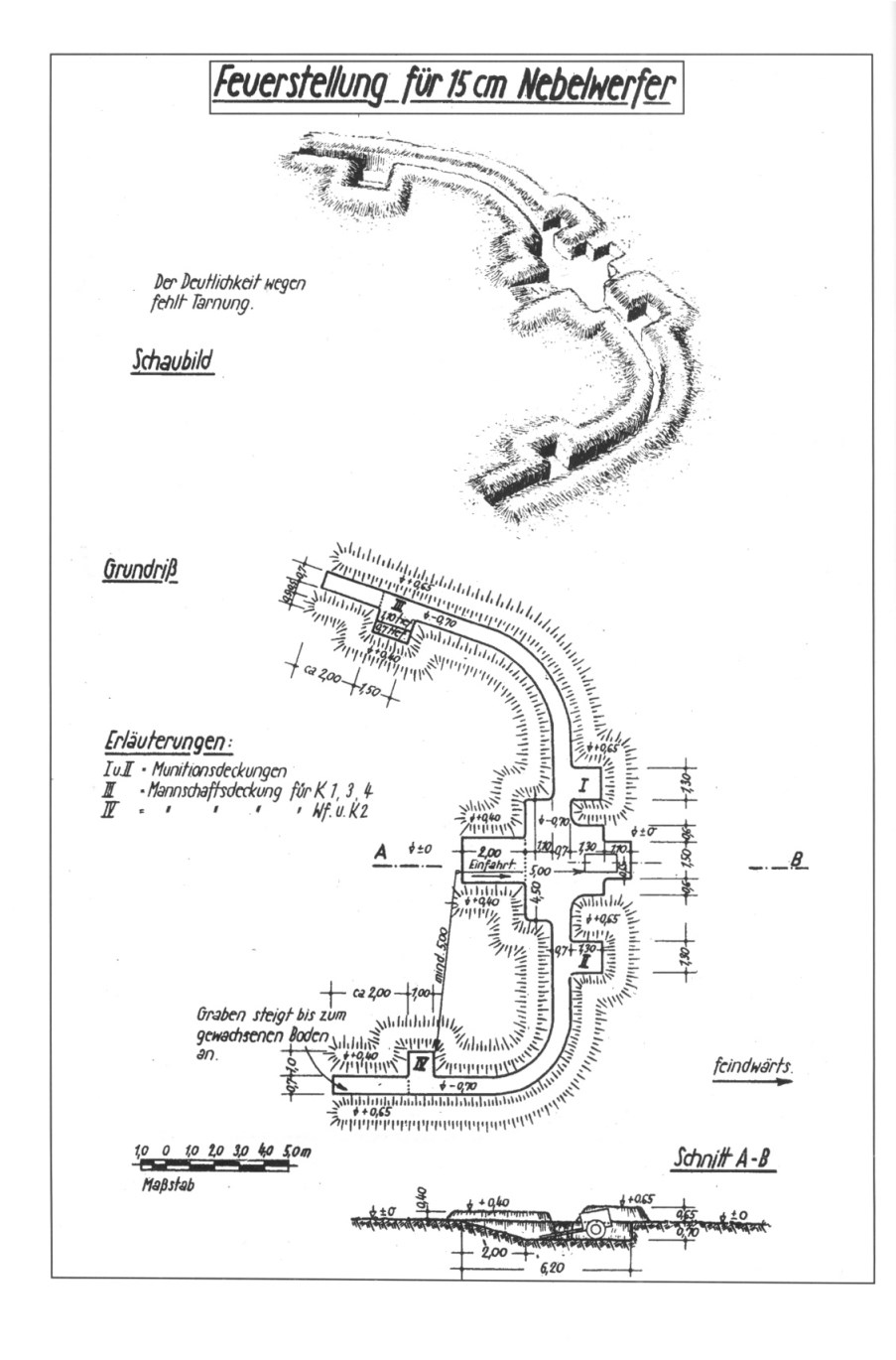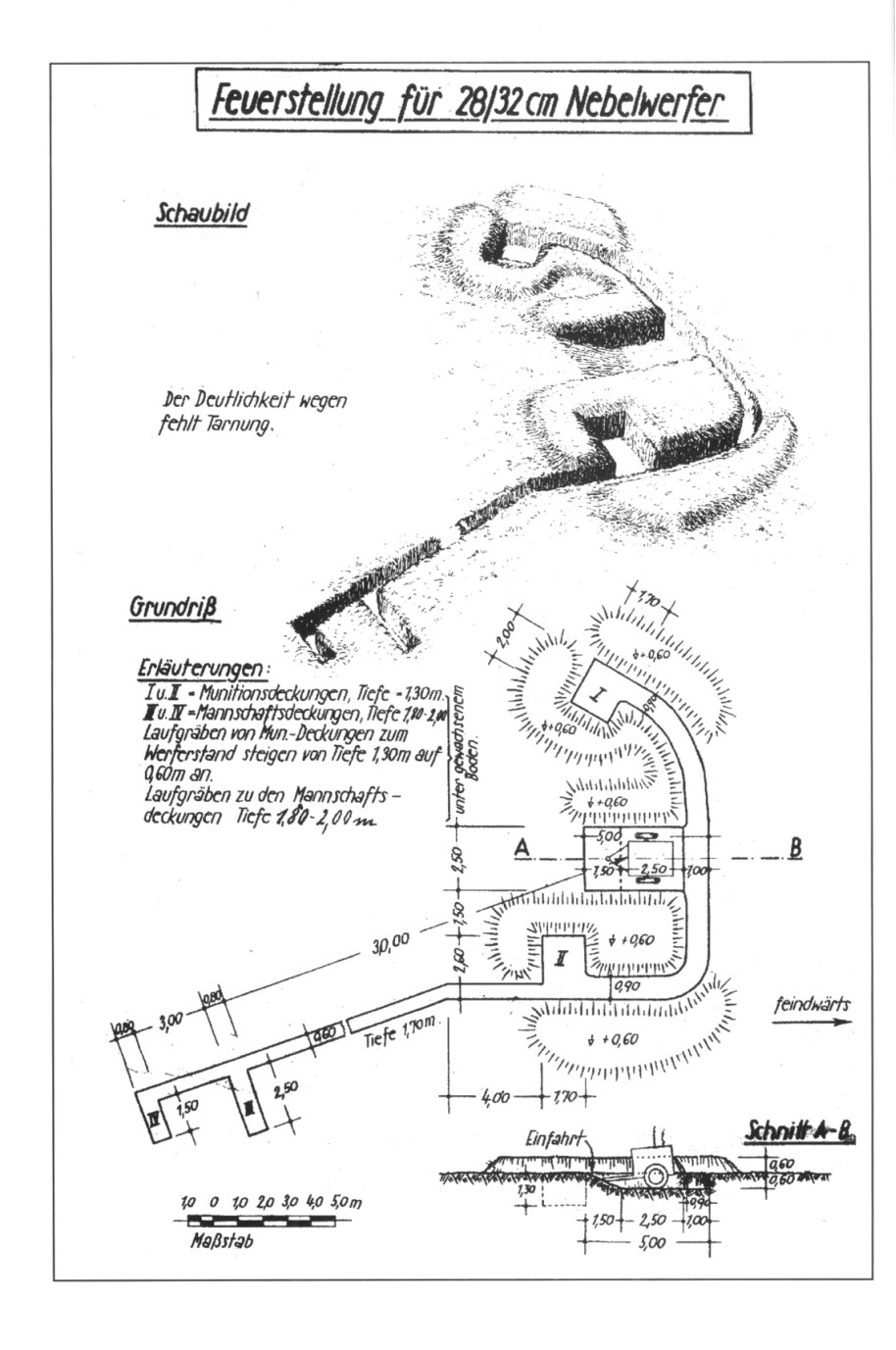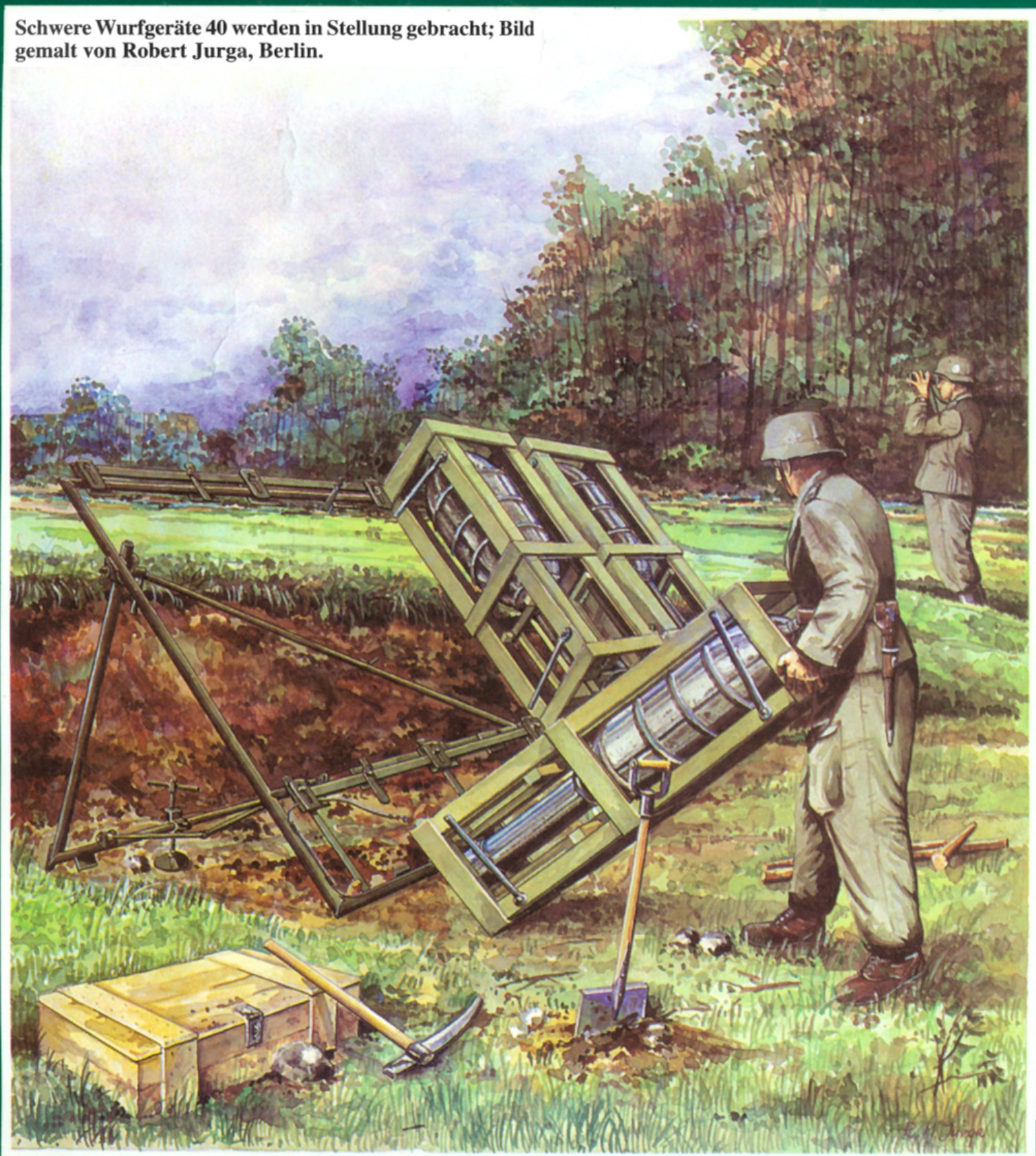
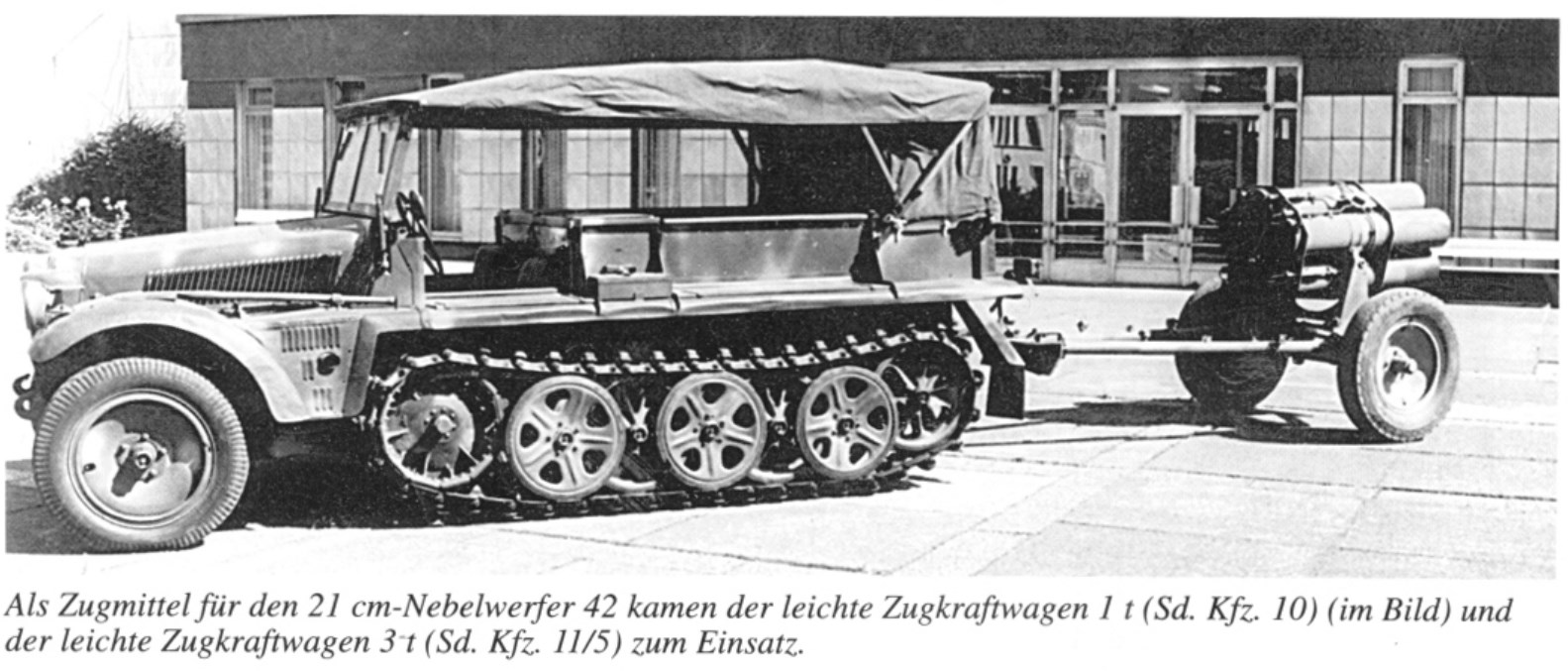
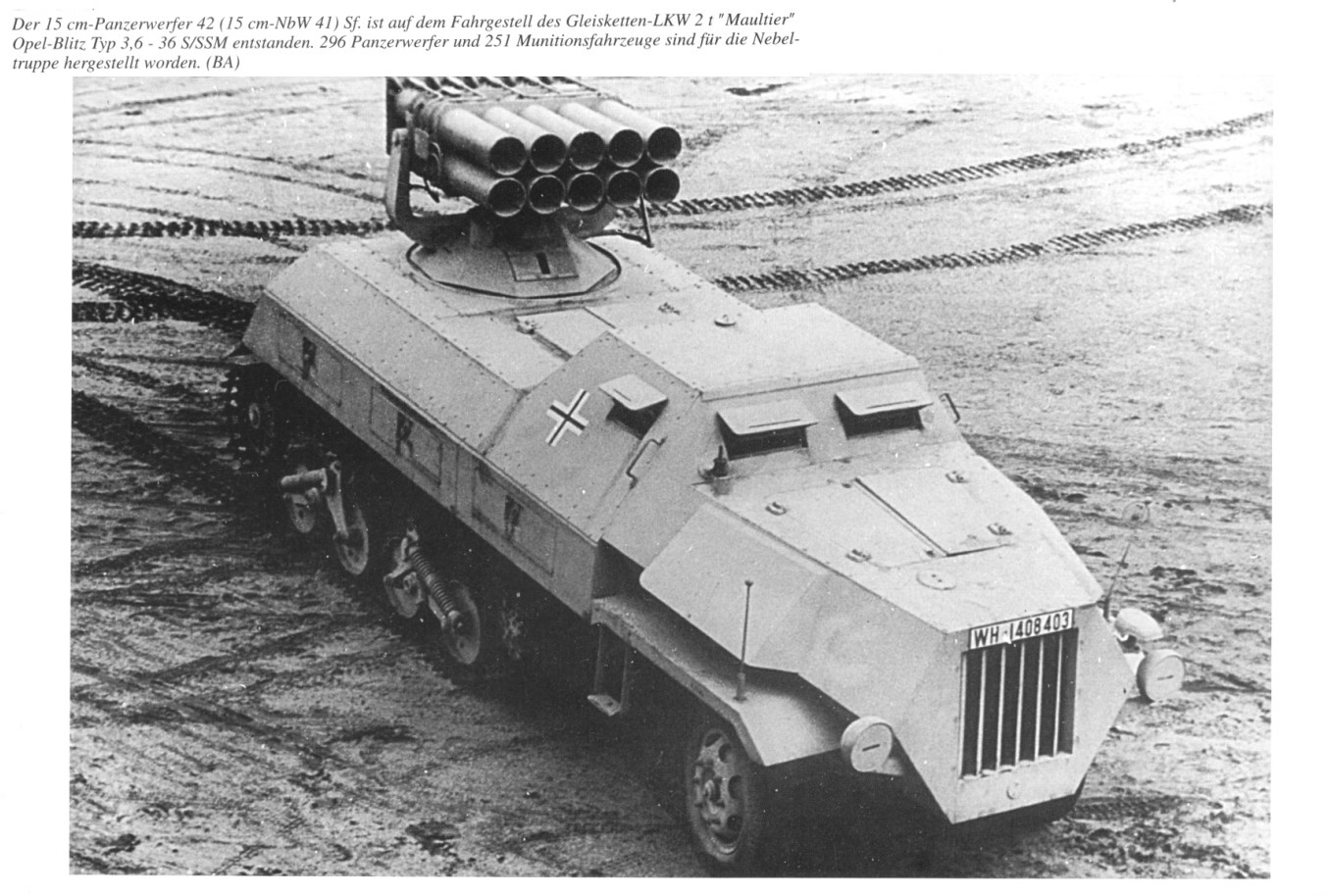
Nebelwerfer, a mobile electronically fired multiple-barrel
rocket launcher (German).
For the Germans, the rocket-propelled shell, such as the
28/320 mm Schweres Wurfgerät 40 and 41 and the 180 mm Raketengranate 4331,
meant easier, quicker, and cheaper shell manufacture and the means to deliver
high weights of shell at less cost in money and in time on the battlefield.
Although strictly speaking not mortars, the Soviet Katyusha,
or “Stalin Organ,” rocket weapons caused the Germans to look carefully at small
rocket-propelled shells. They already had the multi-barreled Minenwerfer
weapons, and soon, they dispensed even with barrels for firing these
projectiles. The 28 cm and 32 cm Nebelwerfer 41 shells and many similar
projectiles were fired from their packing cases. The shells’ weight was such
that they did not need sophisticated sighting systems, just an area to be hit.
These latter-day mortars proved effective in battle, and they were the
forerunners of today’s Multiple Launch Rocket Systems (MLRS).
Not content with a good thing, the Germans as ever were
forced to employ the Maultiers for yet another purpose. The German Nebelwerfer
(rocket) batteries had become an established part of the army artillery system by
late 1942, and it was decided that the Panzer formations should have their own
dedicated rocket units. At that time most Nebelwerfer units used towed
launchers, so in order to keep up with the Panzers a self-propelled version was
required. The halftrack was the obvious choice as a starting point, but as none
could be allocated the Maultier was pressed into use.
The basic truck was provided with a fully armoured cab,
engine cover and hull. On the hull roof a 10-barrel launcher known as the 15-cm
Panzerwerfer 42 was placed. This launcher had 270° of traverse and 80° of
elevation, and it fired the 10 rockets in a ripple. The army ordered 3,000 of
these conversions with the understanding that production would eventually
switch to the SWS when production totals of the latter allowed, which they
never did (apart from a small batch of prototypes). The first of these
Maultiers was used during 1943, and had a crew of three. The rockets were
carried in the launcher, with reloads in compartments along each side of the
lower hull. A machine-gun was usually carried. Some of these armoured Maultiers
were produced without the launcher and were used to carry extra rockets for the
launcher vehicles, and some of these were used by units other than the
Nebelwerfer batteries as front-line ammunition supply vehicles, although their
armour was proof only against small arms projectiles and shell splinters.
Despite their name the Nebelwerfer units were primarily
rocket troops firing their missiles to bolster artillery barrages. The SdKfz
11s used with these batteries not only towed various multi-barrel launchers but
also carried spare rockets, launcher frames for the statically-emplaced
launchers and the crews to carry out the fire missions, Since the Nebelwerfer
units were supposed to retain their smoke-producing skills for laying down
smoke screens at times, some SdKfz 11s (the SdKfz 11/1 and SdKfz 11/4 models)
were fitted with smoke-generating equipment but this could usually be removed
for the more usual rocket-firing duties. These smoke-generating models had a
crew of only two, compared with the nine that could be carried when the vehicle
was used as a tractor.
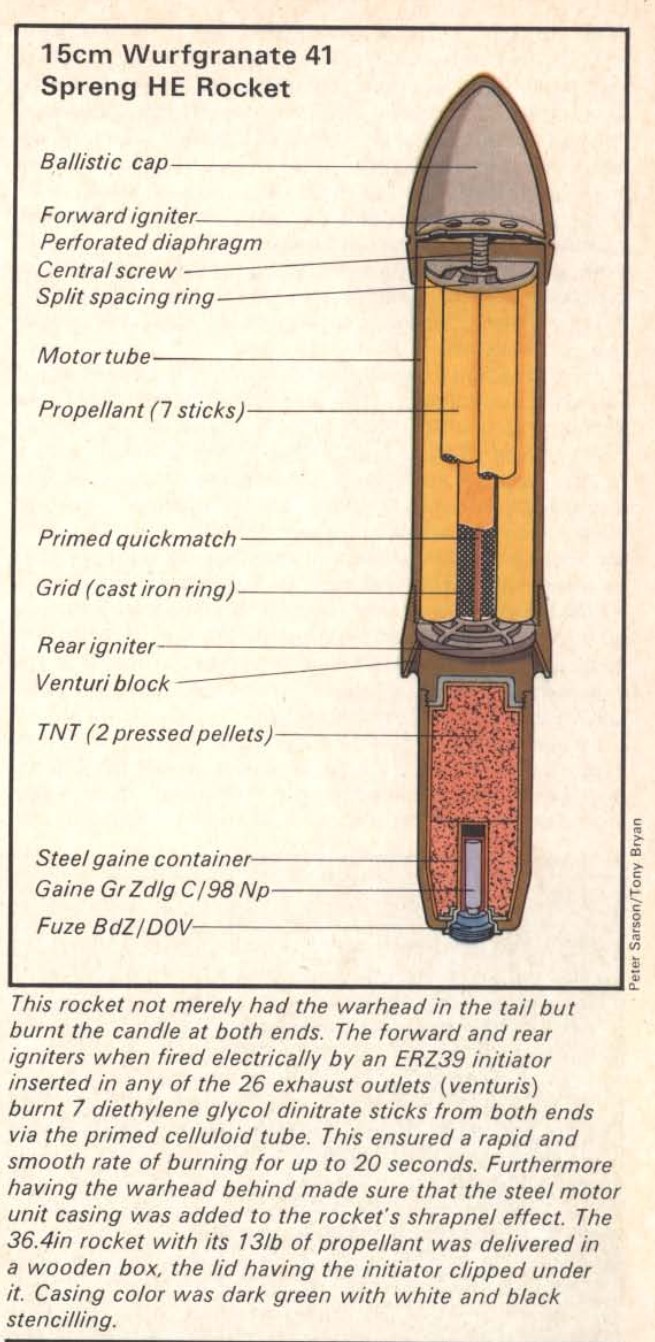
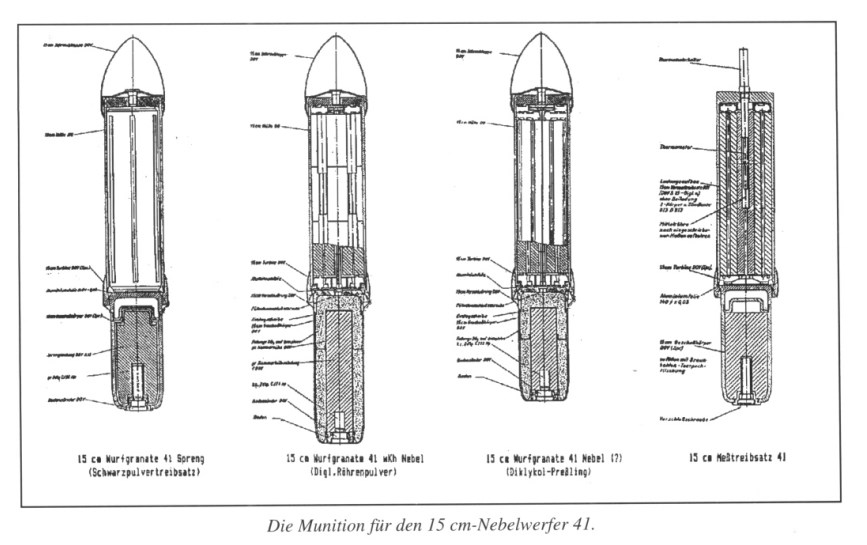
15-cm Wurfgranate
41
The 15-cm (5.9-in) German artillery rockets were the
mainstay of the large number of German army Nebelwerfer (literally
smoke-throwing) units, initially formed to produce smoke screens for various
tactical uses but later diverted to use artillery rockets as well. The 15-cm
(5.9-in) rockets were extensively tested by the Germans at Kummersdorf West
during the late 1930s, and by 1941 the first were ready for issue to the
troops.
The 15-cm (5.9-in) rockets were of two main types: the 15-cm
Wurfgranate 41 Spreng (high explosive) and 15- cm Wurfgranate 41 w Kh Nebel
(smoke). In appearance both were similar and had an unusual layout, in that the
rocket venturi that produced the spin stabilization were located some
two-thirds of the way along the rocket body with the main payload behind them.
This ensured that when the main explosive payload detonated the remains of the
rocket motor added to the overall destructive effects. In flight the rocket had
a distinctive droning sound that gave rise to the Allied nickname ‘Moaning
Minnie’. Special versions were issued for arctic and tropical use.
The first launcher issued for use with these rockets was a
single-rail device known as the ‘Do-Gerät’ (after the leader of the German
rocket teams, General Dornberger). It was apparently intended for use by
airborne units, but in the event was little used. Instead the main launcher for
the 15-cm (5.9-in) rockets was the 15-cm Nebelwerfer 41. This fired six rockets
from tubular launchers carried on a converted 3.7-cm Pak 35/36 anti-tank gun
carriage. The tubes were arranged in a rough circle and were fired electrically
one at a time in a fixed sequence. The maximum range of these rockets was
variable, but usually about 6900m (7,545 yards), and they were normally fired
en masse by batteries of 12 or more launchers. When so used the effects of such
a bombardment could be devastating as the rockets could cover a considerable
area of target terrain and the blast of their payloads was powerful.
On the move the Nebelwerfer 41s were usually towed by light
halftracks that also carried extra ammunition and other equipment, but in 1942
a half-tracked launcher was issued. This was the 15-cm Panzerwerfer 42 which
continued to use the 15-cm (5.9-in) rocket two horizontal rows of five on the
top of an SdKfz 4/1 Maultier armoured halftrack. These vehicles were used to
supply supporting fire for armoured operations. Up to 10 rockets could be
carried ready for use in the launcher and a further 10 weapons inside the
armoured body. Later in the war similar launchers were used on armoured schwere
Wehrmachtschlepper (SWS) halftracks that were also used to tow more Nebelwerfer
4 Is, The SWS could carry up to 26 rockets inside its armoured hull.
The 15-cm (5.9-in) rockets were also used with the launchers
intended for the 30-cm (11.8-in) rockets, with special rails for the smaller
rockets fitted into the existing 30-cm (11.8-in) launcher rails.
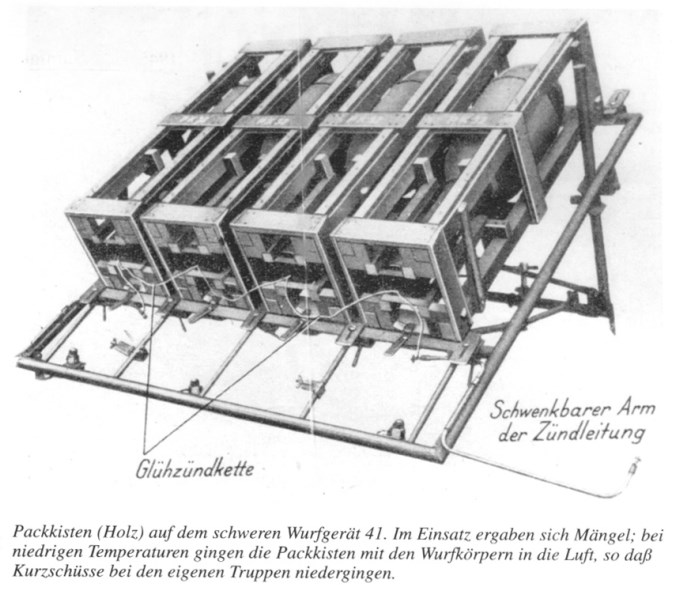
Specification
15-cm Wurfgranate 41 Spreng
Dimensions: length 979 mm (38.55 in); diameter 158 mm (6.22
in)
Weights: overall 31.8 kg (70 lb); propellant, 35 kg(14 lb);
filling2.5 kg(5.5 lb)
Performance: initial velocity 342 m (1,120 ft) per second;
range 7055 m (7,715 yards)
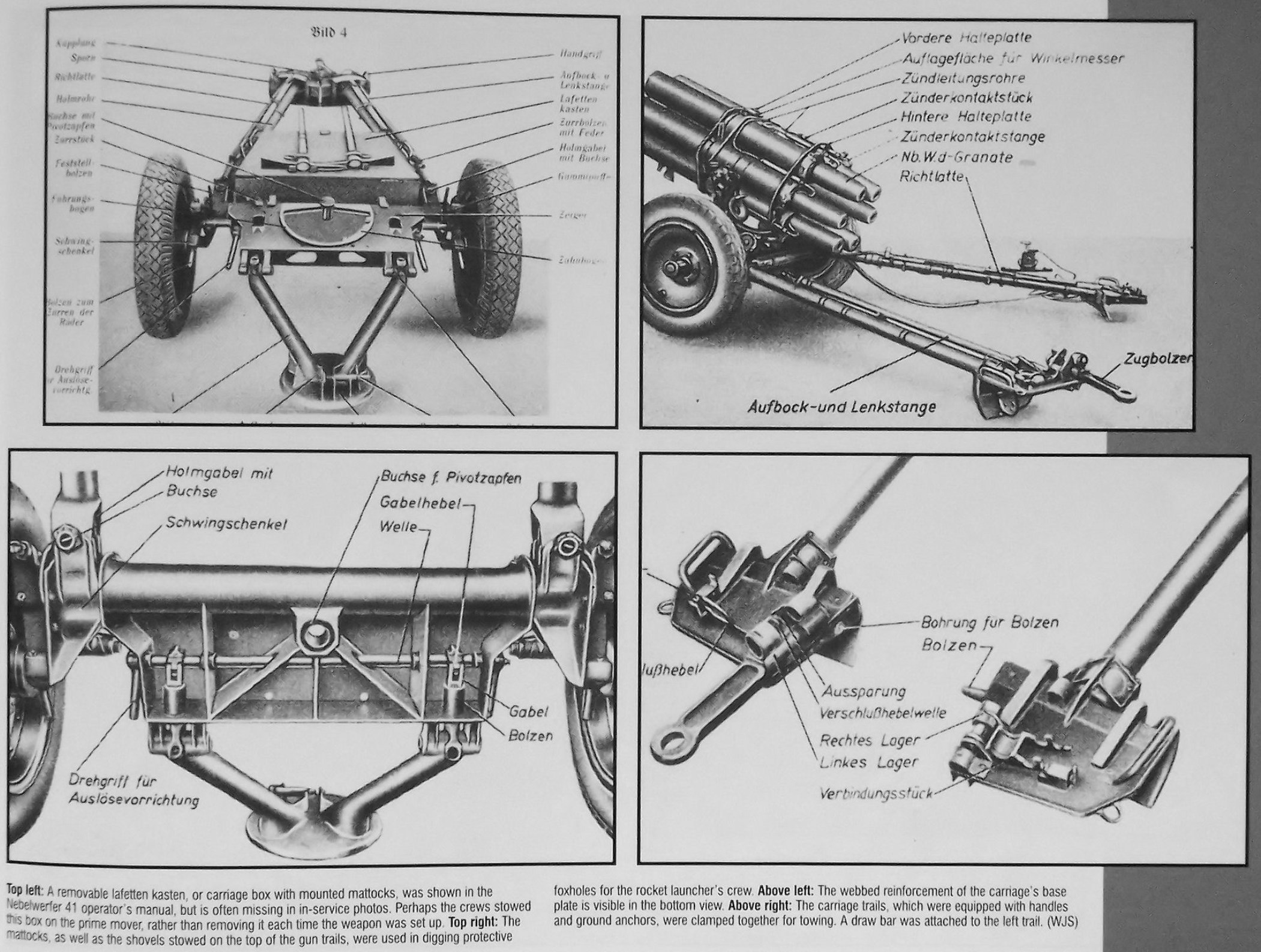
Specification
15-cm Wurfgranate 41 w
Kh Nebel
Dimensions: length
1.02 m (40.16 in); diameter 158 mm (6.22 in)
Weights: overall 35.9
kg (79 lb); propellant 6.35 kg (14 lb); filling 3.86 kg (8.5 lb)
Performance: initial
velocity 342 m (1,120 ft) per second; range 6905 m (7,550 yards)
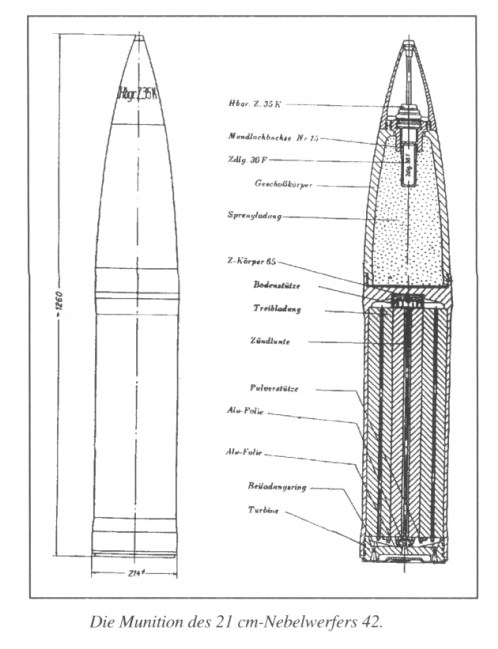
21-cm Wurfgranate
42
Following on from the
success of their 15-cm (5.9-in) rockets, German designers decided to produce a
larger rocket which by 1941 emerged as a 210-mm (8.27-in) design. At first
sight this rocket, known as the 21-cm Wurfgranate 42 Spreng, looked exactly
like a conventional artillery projectile, but closer examination showed that
the base had 22 angled venturi to impart the important spin stabilization. The long
streamlined nose was also deceptive, for it was hollow and the warhead proper
was located some distance from the tip. This rocket contained no less than
10.17 kg (22.4 lb) of high explosive, which on detonation produced a powerful
blast effect. The weapon was so successful in this destructive role that only
high explosive versions were produced.
The 21-cm (8.27-in)
rocket was used with only one type of projector, the 21-cm Nebelwerfer 42. The
first such equipment appeared in action in the Soviet Union during 1943 as it
took some time to finalize the launcher design. Originally this was to have
been a simple enlargement of the existing 15- cm (5.9-in) Nebelwerfer 41
complete with six launcher tubes, but the larger calibre gave rise to some
imbalance problems when the launcher was being towed and fired, so the number
of tubes was eventually reduced to five and that solved the problems. In all
other respects the carriage was the same as the earlier design and was a
modification of the 3.7-cm (1.456-in) Pak 35/36 anti-tank gun carriage. As with
the 15-cm (5.9-in) rockets the firing of the 21-cm (8.27-in) weapon was by
electrical means. Once the rockets had been loaded in their tubes the launcher
crew withdrew to a safe distance (or even took cover), and on receipt of the
firing order one of the crew operated a special switch-gear box and the full
load of rockets were fired one at a time in a fixed sequence. The salvo firing
of the rockets produced a considerable amount of smoke and dust that revealed
the launcher and battery position to the enemy, and during their trajectory the
rockets produced their characteristic moaning noise that made them so
distinctive a weapon. This combination of smoke, dust and noise meant that the
Nebelwerfer troops had to be experts at getting in and out of action quickly,
for any firing of the large salvoes necessary to cover a target quickly
produced counter-battery artillery or rocket fire that could neutralize the
launcher units.
The 21-cm (8.27-in)
rockets made a considerable impression on all who had to endure their effects,
and the Americans in particular considered the rocket and launcher design to be
so far in advance of anything they could produce that they took some examples
back to the USA and copied them. The US version was the 210-mm (8.27-in) T36,
which was used for a series of trials and research programmes that did nothing
to produce an operational weapon but which added considerably to the Americans’
knowledge of artillery rocket technology.
Specification
21-cm Wurfgranate 42
Spreng
Dimensions: length
1.25 m (49.21 in); body diameter 210 mm (8.27 in)
Weights: overall
109.55 kg (241.5 lb); propellant 18.27 kg (40.25 lb); explosive 10.17 kg (22.4
lb)
Performance: initial
velocity 320 m (1,050 ft) per second; range about 7850 m (8,585 yards)
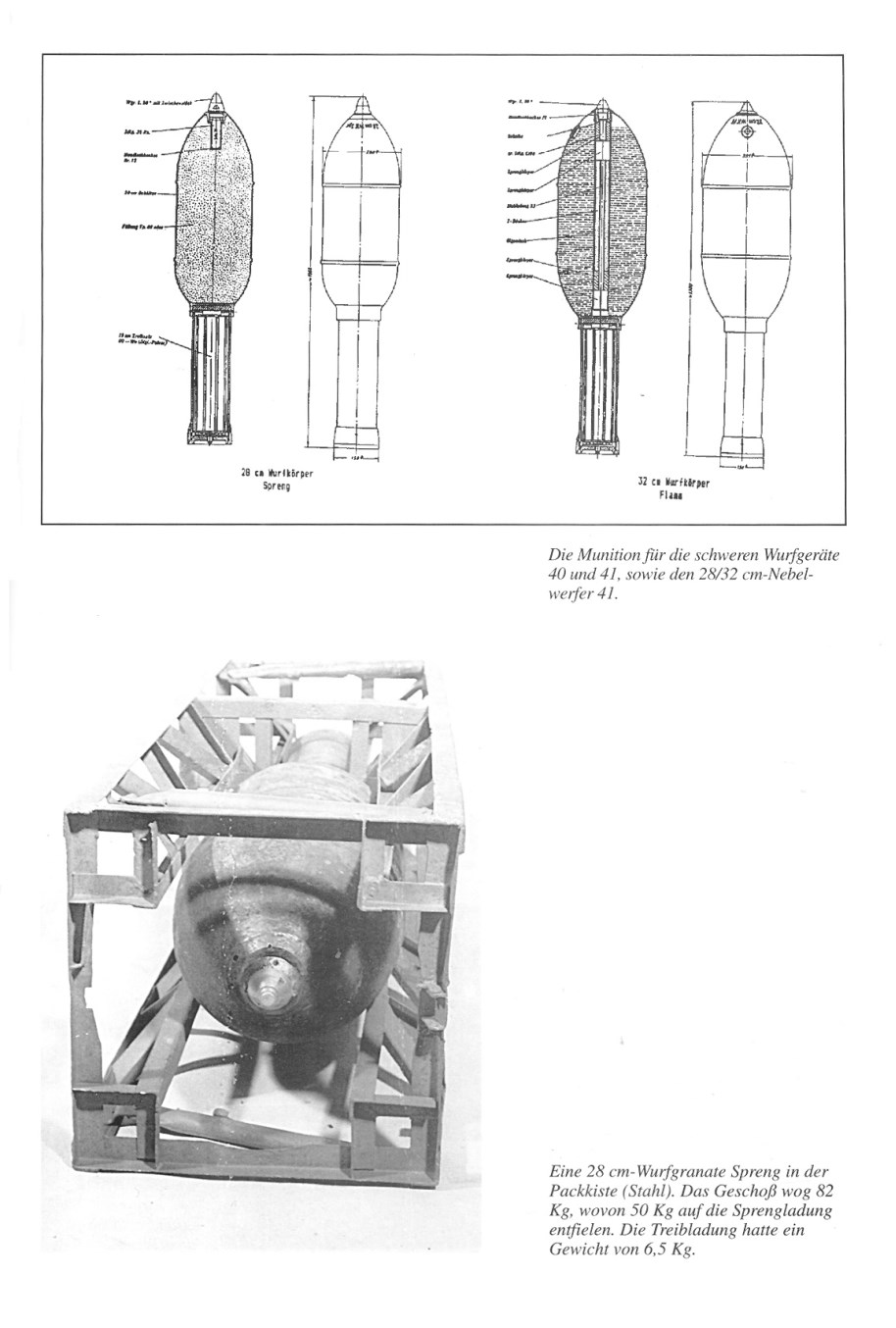
28-cm and 32-cm
Wurfkörper
The 28-cm (11-in) and
32-cm (12.6-m) rockets preceded the 15-cm (5.9-in) rockets in service with the
German army, the first of them being issued for use during 1940. The two
rockets shared the same rocket motor, but differed in their payload. Both were
awkward and- bulky rockets with a poor ballistic shape, but both had powerful
payloads.
The smaller weapon was
the 28-cm Wurfkörper Spreng, which used a heavy high explosive warhead, while
the larger weapon was the 32-cm Wurfkörper M FI 50 with an incendiary warhead
in heavy liquid form. Both had a range limitation of just over 2000 m (2,185
yards) and were highly inaccurate despite their spin stabilization, and were
consequently used en masse whenever possible, Counterbalancing these
disadvantages was the fact that both were devastating in their effects if they
hit a target, and the high explosive rocket was highly regarded for use in
urban fighting where houses or other structures had to be demolished.
Both rockets were
issued to the troops in wooden carrying crates, or Packkiste. These crates
doubled as launching frames and were fitted with simple forward supporting legs
for rudimentary aiming purposes. In this form both rockets could be used by
assault pioneers to demolish bunkers or strongpoints, but more often the
rockets were used in batches of four resting on simple launcher frames known as
the schweres Wurfgerät 40 or schweres Wurfgerät 41, which differed from each
other only in that the latter was tubular steel- rather than wooden-framed.
Both could be used for pre-arranged barrages, as during the siege of Sevastopol
in 1942. But this launching method was static, and to provide some form of
mobility the 287 32-cm Nebelwerfer 41 was developed. This was a simple trailer
with frames for six rockets in two superimposed rows of three, and after the
15-cm Nebelwerfer 41 this launcher was the most important early equipment of
the Nebelwerfer units.
Another and still more
mobile launcher for these rockets was the schwerer Wurfrahmen 40, in which six
launcher frames were mounted on the sides of an SdKfz 251/1 half-track. The
rockets were mounted on the side frames still in their carrying crates. Aiming
was achieved by simply pointing the vehicle towards the target, and the rockets
were then fired one at a time in a set sequence. This rocket/ vehicle
combination had several names but was often known as the ‘Stuka- zu-Fuss’ or ‘heulende
Kuh’ (Foot Stuka or Howling Cow) and was often used to support Panzer
operations, especially in the early days of the invasion of the Soviet Union.
Later in the war other vehicles, usually captured French or other impressed
vehicles, were used to bulk out the numbers of mobile launchers available. All
manner of light armoured vehicles were used in this role, some carrying only four
launchers. Many of these improvised launcher vehicles were used during the
fighting in Normandy in 1944.
Specification
28-cm Wurfkörper
Spreng
Dimensions: length
1.19m (46.85 in); body diameter 280 mm (11 in)
Weights: overall 82.2 kg
(181 lb); propellant 6.6 kg (14.56 lb); filling 49.9 kg (110 lb)
Performance: range
about 2138 m (2,337 yards)
Specification
32-cm Wurfkörper M
F150
Dimensions: length
1.289 m (50.75 in); body diameter 320 mm (12.6 in)
Weights: overall 79 kg
(174 lb); propellant 6.6 kg (14.56 lb); filling 39.8 kg (87.7 lb)
Performance: range
about 2028 m (2,217 yards)
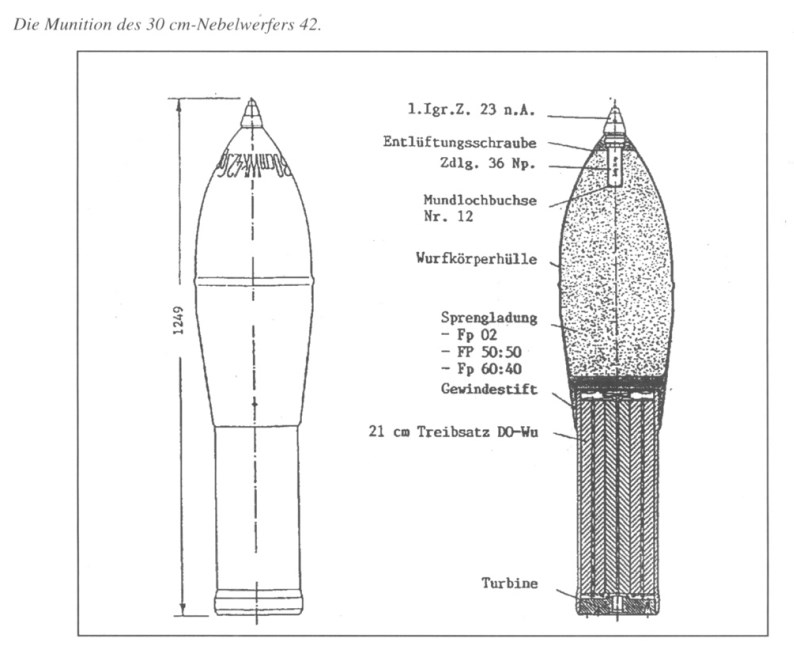
30-cm Wurfkörper 42
Compared with 28-cm
(11-in) and 32- cm (12.6-in) rockets which preceded it, the 30-cm Wurfkörper 42
Spreng (also known as the Wurfkörper Spreng 4491) was a considerable
improvement on the earlier designs when it appeared on the artillery scene
during late 1942. Not only was it in aerodynamic terms a much smoother and
cleaner design, but it had a much higher propellant/payload ratio than any other
German artillery rocket. However, to the troops in the fields these
technicalities were far less important than the fact that the more advanced
type of propellant used with the new rocket produced far less smoke and exhaust
trails than the other rockets, and was thus far less likely to give away the
firing position. But for all this improvement the 30-cm (11.8-in) rocket did
not have any marked range advantages over the existing rockets. It had a
theoretical range of some 6000 m (6,560 yards), but practical ranges were of
the order of 4550 m (4,975 yards).
The first launcher
used with the new 30-cm (11.8-in) rockets was the 30-cm Nebelwerfer 42, This
was a simple conversion of the 28/32-cm Nebelwerfer 41 with the simple rail
launching frames altered to accommodate the new rocket shape and size. But this
simple conversion did not last long, for almost as it was issued a new
programme of rationalization was drawn up and the special trailer of the
Nebelwerfer 41 and 42 was eliminated. Instead a new trailer based on the
carriage of the 5-cm (1.97-in) Pak 38 anti-tank gun was placed into production
and the 30-cm (11.8-in) launcher frames were placed on this to produce the
30-cm Raketenwerfer 56; to ensure that the new launcher could be used to the
maximum each was provided with a set of launcher rail inserts to allow 15- cm
(5.9-in) rockets to be fired if required. When not in use, these 15-cm (5.9-in)
rails were stacked on top of the 30-cm (11.8-in) frames. Yet another
rationalization was that the 30-cm (11.8- in) rockets could also be fired from
the schwerer Wurfrahmen launcher frames of the SdKfz 251/1 half-track,
originally intended for use by the 28- cm (11-in) and 32-cm (12.6-in) rockets.
When launched from these frames, the 30-cm (11.8-in) rockets were fired from
their carrying crates or Packkiste, and no doubt the 30-cm (11.8-in) rockets
were used by assault pioneers for direct firing from their crates in the same
manner as the earlier 28-cm (11- in) and 32-cm (12.6-in) weapons.
Despite its relative
improvements over the earlier artillery rockets, the 30-cm (11.8-in) rocket was
not used in very great numbers. The earlier rockets remained in service right
until the end of the war despite a late attempt to replace all existing
weapons, including the 30-cm (11.8-in) type, by an entirely new 12-cm (4.72-in)
spin-stabilized design, This decision was made too late in the war for anything
actually to reach the troops, and it now appears doubtful if any 12-cm
(4.72-in) rockets were ever made.
Specification
30-cm Wurfkörper 42
Dimensions: length
1.23 m (48.44 in); body diameter 300 mm (11.8 in)
Weights: overall 125.7
kg (277 lb); propellant 15 kg (33.07 lb); explosive 44.66 kg (98.46 lb)
Performance: initial
velocity 230 m (754 ft) per second; range about 4550 m (4,975 yards)
8 cm Raketen-Vielfachwerfer
The Waffen-SS decided to copy the Soviet
82 millimetres (3.2 in) M-8 Katyusha
Rocket-Launcher as the twenty-four rail 8 cm Raketen-Vielfachwerfer.
Its fin-stabilized rockets were cheaper and easier to manufacture than the
German spin-stabilized designs and used cheap launch rails. It was also capable
of using the considerable stocks of captured Soviet rockets. Separate
production lines were set-up under Party control as the Army refused to convert
any of its existing factories, but not many actually appear to have been made.
Production quantities are unknown, but photographic evidence shows the launcher
mounted on lightly armored versions of the Sd.Kfz. 4 “Maultier” and
the captured French SOMUA MCG half-track.
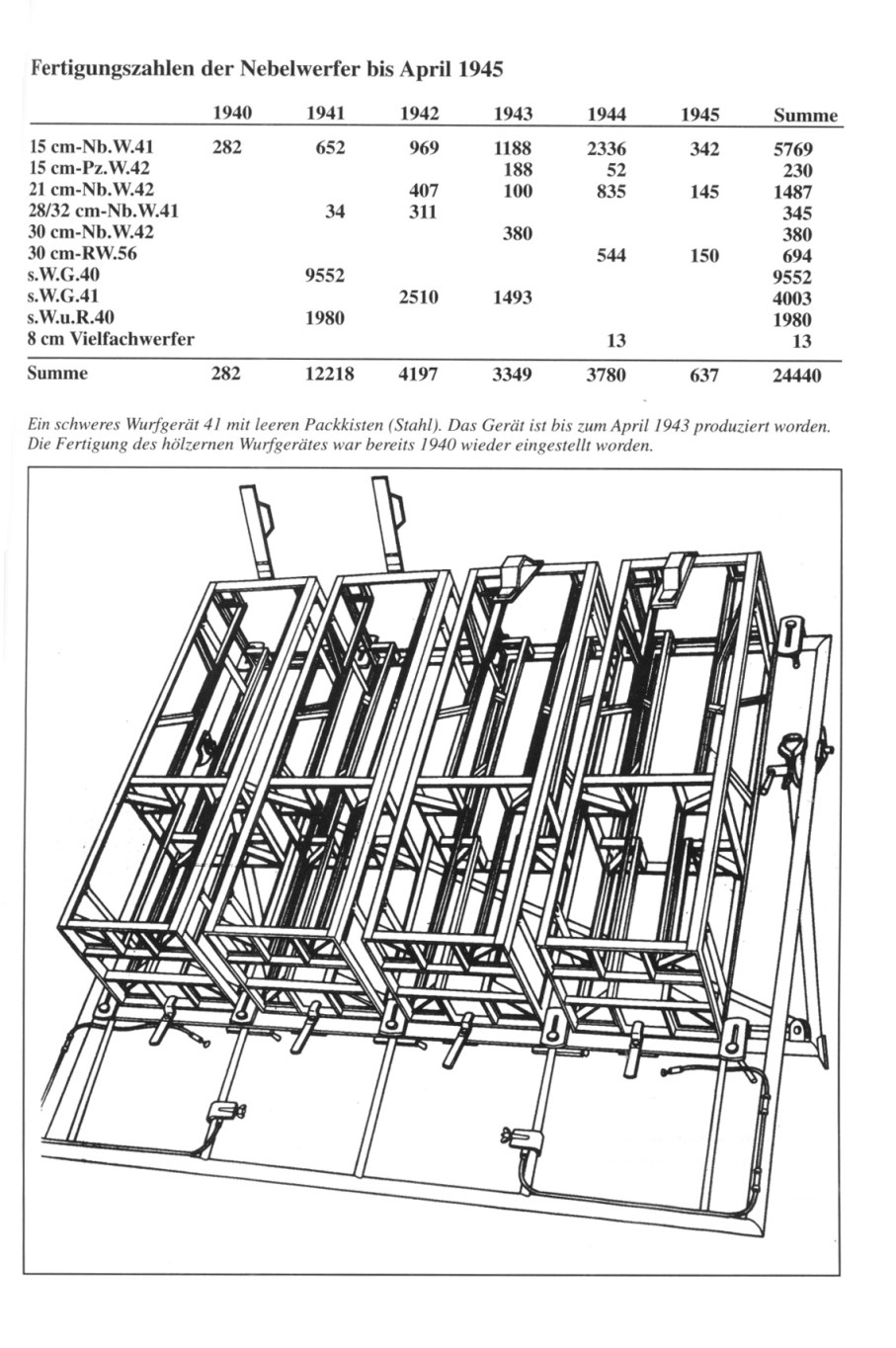
Summary
The Soviet Katyusha rockets were fin stabilised and hence
could be launched from rails. These rockets were 82mm or 132 mm diameter and their
rail launchers were truck mounted in general although eg T60 light tank chassis
and STZ 5 artillery tractors were also used but in much smaller numbers. The
soviets also used a 300mm rocket fired from a 4 unit static, ie ground mounted,
rack.
Ranges:
82mm 5500 metres
132mm 8500 metres
300mm 2800 metres
The German Nebelwerfer rockets were spin stabilised. The rockets were fired
from either
-a 2 wheeled trailer fitted with 6 short tubes arranged in a circle – 15cm
Nebelwerfer 41.
-a 2 wheeled trailer fitted with 5 short tubes arranged in a circle – 21cm
Nebelwerfer 42.
-a 2 wheeled trailer fitted with 6 launcher frames arranged in 2 rows of 3
28/32 cm Nebelwerfer 41.
-a 2 wheeled trailer fitted with 6 launcher frames arranged in 2 rows of 3 30
cm Nebelwerfer 42. (This was the same as the 28/32cm Nebelwerfer 41 adapted for
the 30cm rocket)
Packkiste: This was the rockets carrying case. The rocket could be fired from
this case as a single round if needed.
Schweres Wurfgerat 40 and 41: Made of wood (40) or steel tubing (41) these were
frames onto which the packkiste were fitted. 4 packkiste were fitted to each
frame.
Schweres Wurfahmen 40. This was a special steel tube frame fitted to the side
of a SdKfz 251. They could be fitted with the packkiste of the 28/32cm rocket.
3 were fitted to each side of a SdKfz 251.
A simpler version consisting of a frame for 4 packkiste was fitted to eg
Infantrie Schlepper UE (f) and the PzKpfw 35H(f).
15cm Panzerwerfer 42
A 10-barrelled launcher with its tubes arranged in 2 banks of 5 set one atop the other. These tubes were the same as the Nebelwerfer 41. The Panzerwerfer 42 had a traverse of 270 degrees and could elevate yup to 80 degrees. It was fitted to an armoured Sdkfz4/1 Maultier half track.
The 8cm R Vielfachwerfer was basically a copy of the soviet fin-stabilsed 82mm rocket and was fired from the same type of rail launcher.
Ranges:
15cm Wurfgranate 41 Spreng c 7000m
21cm Wurfgranate 42 Spreng c 9000m
28cm Wurfkorper Spreng c 2200m
32cn Wurfkorper M Fl 50 c 2000m (incendiary round)
30cm Wurfkorper 42 Spreng 6000m
